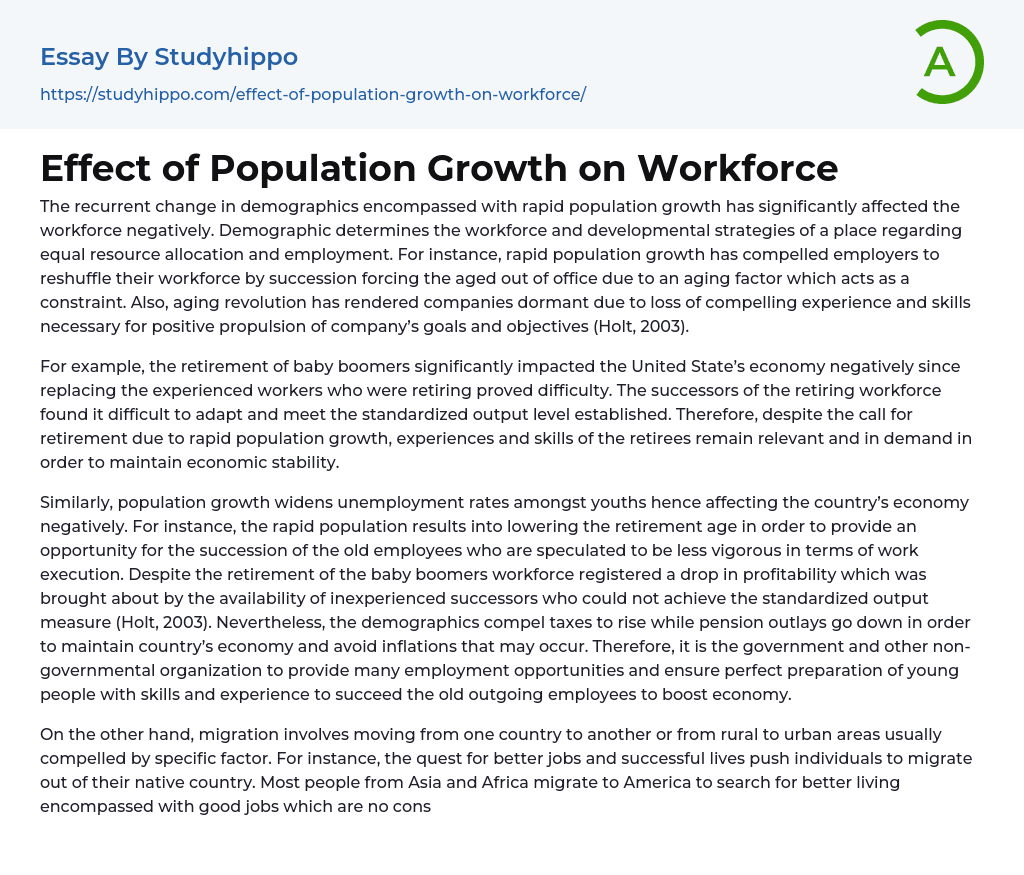The recurrent change in demographics encompassed with rapid population growth has significantly affected the workforce negatively. Demographic determines the workforce and developmental strategies of a place regarding equal resource allocation and employment. For instance, rapid population growth has compelled employers to reshuffle their workforce by succession forcing the aged out of office due to an aging factor which acts as a constraint. Also, aging revolution has rendered companies dormant due to loss of compelling experience and skills necessary for positive propulsion of company’s goals and objectives (Holt, 2003).
For example, the retirement of baby boomers significantly impacted the United State’s economy negatively since replacing the experienced workers who were retiring proved difficulty. The successors of the retiring workforce found it difficult to adapt and meet the standardized output level established. Therefore, despite the call for
...retirement due to rapid population growth, experiences and skills of the retirees remain relevant and in demand in order to maintain economic stability.
Similarly, population growth widens unemployment rates amongst youths hence affecting the country’s economy negatively. For instance, the rapid population results into lowering the retirement age in order to provide an opportunity for the succession of the old employees who are speculated to be less vigorous in terms of work execution. Despite the retirement of the baby boomers workforce registered a drop in profitability which was brought about by the availability of inexperienced successors who could not achieve the standardized output measure (Holt, 2003). Nevertheless, the demographics compel taxes to rise while pension outlays go down in order to maintain country’s economy and avoid inflations that may occur. Therefore, it is the government and other non-governmental organization to provide many
employment opportunities and ensure perfect preparation of young people with skills and experience to succeed the old outgoing employees to boost economy.
On the other hand, migration involves moving from one country to another or from rural to urban areas usually compelled by specific factor. For instance, the quest for better jobs and successful lives push individuals to migrate out of their native country. Most people from Asia and Africa migrate to America to search for better living encompassed with good jobs which are no considered unique and rare back at their countries (Ottaviano & Giovanni, 2010).
Also, the immigration into another country helps in the buildup of the host country economy due to the provision of skilled and unskilled labors which boost the country’s workforce. Immigration causes a decline in resource per-capita, and this compels the government to place a restriction on immigration by ensuring security at the borders and airports to avoid illegal trespass. For instance, immigration causes population increase which leads to sharing of the scarce resources with the inhabitants resulting in inefficiency due to the distribution of resources that would otherwise satisfy the inhabitants.
Nevertheless, immigration has caused unemployment rate within the country go high rendering some of the inhabitants jobless. The kind of situation has triggered demonstrations and disputes from the inhabitants who view the immigrants as a reason for their unemployment. For instance, in South California inhabitants conducted demonstration aimed at articulating their unemployment grievances in a platform they considered employing immigrants and curtailing the inhabitants’ employment (Ottaviano & Giovanni, 2010).
Similarly, rural-urban migration has been witnessed both in the past and now triggered by a search of better living and jobs. As
such, the people migrating to urban areas must take precautions of lack of jobs to the unskilled people and adapt to the fast moving system in urban areas. Therefore, migration results into subsequent population increase encompassed with an increase in unemployment rates and disputes.
References
- Falk, D. R., Moss, S., Shapiro, M., & Aughenbaugh, S. (2010). Educating globally competent citizens: A tool kit for teaching seven revolutions. Washington, DC: Center for Strategic and International Studies.
- Holt, S. (2003). The Aging Impact of Populations. NOVA, NO Pages.
- Ottaviano, I. G. (2010). Immigration
- Offshoreing and American Jobs. the National Bureau of Economic Research, no pages.




